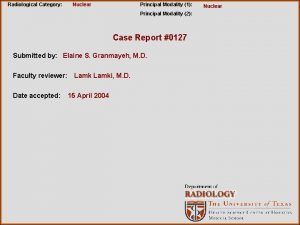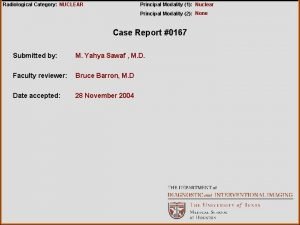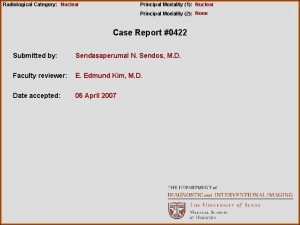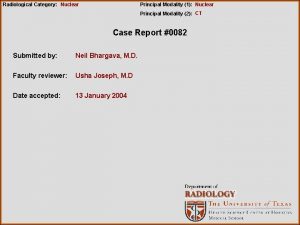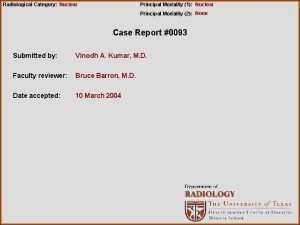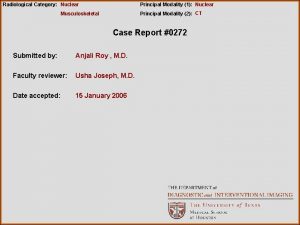Radiological Category Nuclear Principal Modality 1 Principal Modality










- Slides: 10

Radiological Category: Nuclear Principal Modality (1): Principal Modality (2): Case Report #0127 Submitted by: Elaine S. Granmayeh, M. D. Faculty reviewer: Date accepted: Lamki, M. D. 15 April 2004 Nuclear

Case History A male in his fifties with lung cancer. Nuclear bone scan was performed to evaluate for metastases.

Radiological Presentations

Test Your Diagnosis Which one of the following is your choice for the appropriate diagnosis? After your selection, go to next page. • Diffuse bony metastases • Hyperparathyroidism • Paget’s Disease • Hypertrophic Osteoarthropathy • Renal Osteodystrophy

Findings and Differentials Bone Scan Findings : --Linearly increased activity along the cortical shafts of the femora, tibiae, fibulae, ulnae, humeri and also metacarpals of the hands --Increased uptake in the sternum Differential: • Hypertrophic Osteoarthropathy • Renal Osteodystrophy • Diffuse bony metastases

Discussion The differential diagnosis for this case includes hypertrophic osteoarthropathy, renal osteodystrophy and other metabolic bone disease, with diffuse bony metastases and Paget’s disease less likely. In Paget’s disease of bone, focally increased uptake is seen in both the lytic and sclerotic phases. Pelvis is the most commonly involved site followed by the spine, skull, femur, scapula, tibia and humerus. The most common clinical application of the bone scan is to evaluate patients for metastases. These lesions can be detected because of the osteoblastic reaction they evoke. Metastatic disease usually presents as solitary or multiple focal lesions. If there is diffuse and uniform skeletal involvement, the scan may appear deceptively normal and is referred to as “superscan”. This term is used to describe widely metastatic disease whereby the only clues to the extent of bony uptake are an unusually good ratio of bone to soft tissue activity, absent or faint visualization of the kidneys, and increased accumulation in the axial versus appendicular skeleton. Another scintigraphic pattern in metastatic disease is photon-deficient “cold” lesions due to purely osteoclastic processes. Finally, a bone scan show soft tissue metastases if tracer is taken up by tumor. (continued next page)

Discussion (continued) Hyperparathyroidism, hyperthyroidism, osteomalacia, hypervitaminosis D and renal osteodystrophy can all result in generally increased uptake throughout the skeleton. These cases can be distinguished from the superscan of metastatic disease by certain features including increased activity in the skull, long bones of the extremities and periarticular regions. Total absence of kidney and bladder activity makes renal osteodystrophy more likely than the other metabolic disorders. An interesting feature occasionally seen with metabolic bone disease is that of “rachitic rosary, ” which describes the appearance of increased uptake at costochondral junctions. With increased levels of parathyroid hormone or parathyroid hormone-like substances, calcium/phosphate complexes can also deposit in soft tissues such as the thyroid gland, lungs and stomach. This “metastatic calcification” is visible on bone scans. Renal osteodystrophy has particularly characteristic features. Mask-like periorbital accumulation, the “Lone Ranger” sign, is almost pathognomonic, as is uptake in the mandible and maxilla. The sternum is usually prominent (“tie” sign), sometimes with horizontal lines of uptake (“striped-tie” sign). Less specific features include increased activity in the limbs and the costochondral junctions. When primary renal disease delays skeletal maturation, epiphyseal accumulation of radiotracer can be seen. (continued next page)

Discussion (continued) Hypertrophic osteoarthropathy causes periosteal reaction, especially in the long bones. This is detected earlier on bone scan than on plain radiographs. Hypertrophic osteoarthropathy is most commonly associated with ectopic growth hormone production in lung cancer. Bone scan typically shows linearly increased activity along the shafts of the tibiae, femora and radii, particularly around the knees, ankles and wrists. This characteristic pericortical uptake in the long bones is termed the “tram track” sign. Changes in the skull, scapulae, clavicles and patellae (“hot patella” sign) are often demonstrated as well. Increased uptake can also be seen in the sternum, and clinically these patients usually have clubbing of the fingertips. After treatment of the associated disease, there is usually rapid regression of the scintigraphic changes. Clinical improvement precedes improvement on the bone scan, and radiographic improvement occurs even later.

References: Kroon HM and Pauwels EK. Bone scintigraphy for the detection and follow-up of hypertrophic osteoarthropathy. Diagnostic Imaging. 1982; 51(1): 47 -55. Mettler FA and Guiberteau MJ. Essentials of Nuclear Medicine. 4 th Edition, 1998, W. B. Saunders Company, Philadelphia, pp. 309, 326. Murray IPC and Ell PJ. Nuclear Medicine in Clinical Diagnosis and Treatment. Vol. 2, 1994, Churchill Livingstone, New York, pp. 957, 1035 -39. Thrall JH and Ziessman HA. Nuclear Medicine the Requisites. 2 nd Edition, 2001, Mosby, Inc. , St. Louis, pp 117 -21, 138 -9

Diagnosis • Hypertrophic osteoarthropathy
 E-rate category 1 vs category 2
E-rate category 1 vs category 2 Tennessee division of radiological health
Tennessee division of radiological health Center for devices and radiological health
Center for devices and radiological health National radiological emergency preparedness conference
National radiological emergency preparedness conference Radiological dispersal device
Radiological dispersal device Lesson 15 nuclear quest nuclear reactions
Lesson 15 nuclear quest nuclear reactions Fisión nuclear vs fision nuclear
Fisión nuclear vs fision nuclear Modality erd
Modality erd Modality in software engineering
Modality in software engineering Epistemic modality
Epistemic modality Birads scoring
Birads scoring











